Tan Tan Ramen (Tantanmen) is a rich and flavorful Japanese ramen noodle soup adapted from the famous Chinese Sichuan dan dan mian. It’s unique for both its savory topping and the spicy yet creamy soup broth. This hot bowl of ramen is too good to be missed! {Vegetarian and gluten-free options included}

Can we say YES to another delicious, better-than-restaurant ramen recipe? Today I’m bringing you Tan Tan Ramen (or Tantanmen, 坦々麺)—a spicy and superbly flavorful noodle soup bowl you’d need in your life. It is also easy to make and completely customizable. I think you will go wild about it once you try it!
Table of Contents

What is Tan Tan Ramen?
Tan tan ramen—as it is called in the US—is known as tantanmen (坦々麺) in Japan. Unlike classic ramen varieties (mainly shio ramen, miso ramen, and shoyu ramen), tantanmen doesn’t have the usual toppings such as chashu and ramen egg (ajitsuke tamago or ajitama).
The ingredients and seasonings vary depending on the ramen shop. However, the most distinctive feature of tantanmen is the spicy soup made with chili oil and spicy bean paste called doubanjiang. The unique color of the soup broth comes mainly from the sesame paste and soy milk. The flavor of the broth is mellow so that the spiciness can come through. Tan tan ramen is always topped with stir-fried niku miso or sweet and savory ground pork, along with some green vegetables.
There is a layer of complexity to the soup and you get to enjoy the contrast between sweet and spicy ingredients.
History of Tantanmen
You might already know that ramen noodles are a Japanese adaptation of the Chinese Lamian, and the same goes with tantanmen. It is the Japanese variation of the popular Sichuan street food called dandanmian (担担面), or dan dan noodles.
For starters, the original Sichuan noodle dish doesn’t involve a soup broth, but instead served with a spicy sauce topped with savory minced pork, preserved vegetables, and leafy greens. You can read more about the original Dan Dan Noodles from my friends’ blogs at Ominivore’s Cookbook and The Woks of Life.
It is said that the Japanese tantanmen was adapted for the Japanese people by the legendary Chen Kenmin (陳健民). Sichuan-born Chen was called the father of Sichuan cuisine in Japan and made Chinese food more approachable to Japanese people by toning down the fiery spices and using accessible Japanese ingredients.
If you’re interested in this topic, you can continue reading about Japanese Chinese food (Chuka Ryori) in this post.

How to Make Tan Tan Ramen
Ingredients You’ll Need
- Pork mixture: ground pork, ginger, garlic, sake, doubanjiang (spicy chili bean paste), soy sauce
- Sauce: Japanese sesame paste, miso, soy sauce, rice vinegar, la-yu (Japanese chili oil)
- Soup broth: chicken stock, unsweetened soy milk, salt
- Fresh ramen noodles
- leafy green: bok choy
We’ll go over some of the key ingredients below.
Overview: Cooking Steps
- Make the sauce by combining the condiments.
- Cook the ground pork and condiments together to make the pork mixture.
- Make the soup broth by combining chicken broth and soy milk.
- Cook the leafy greens, followed by ramen noodles.
- Assemble the ramen bowl with the cooked noodles, hot soup, and pork mixture.
Substitute Suggestions
- Ground pork – Traditionally it’s ground pork, but you can use other meat like ground chicken or turkey. However, chicken or turkey is leaner and less flavorful than pork. For vegan/vegetarian, you can use meat alternatives or chopped mushrooms.
- Sake – Sake helps to remove the pork’s gamey odor; you also can use Chinese rice wine or dry sherry, or otherwise, skip it.
- Doubanjiang (spicy chili bean paste) – This condiment is an important element for making authentic tantanmen, so I don’t recommend skipping it. For children who don’t eat spicy food, try finding the Taiwanese Lian How (岡山) brand of doubanjiang. If you have trouble finding the chili bean paste, miso is the closest substitute. For gluten-free, you can use this brand.
- Rice vinegar (unseasoned) – Rice vinegar is milder than other kinds of vinegar. Use less, if you need to substitute.
- La-yu (Japanese chili oil) – You can use your favorite chili oil in a pinch. I highly recommend making my Homemade La-Yu recipe.
- Chicken stock – I use store-bought stock. Remember each brand of chicken stock has different saltiness, so you must adjust by diluting with water or adding more salt. For vegan/vegetarian, use vegetable stock or Vegan Dashi.
- Unsweetened soy milk – I use the American brand called Silk. Make sure it’s unsweetened and unflavored. You can also use the Westsoy brand or the one from Trader Joe’s. If you’re allergic to soy, you can try it with oat milk but please know that the flavor is not going to be the same. Soy milk provides the authentic flavor for tantanmen, so I recommend using only soy milk unless you absolutely cannot have it.
- Fresh ramen noodles – If fresh ones are not available, you can use dried ramen noodles. For gluten-free, I highly recommend this brand.

Where to Buy Fresh Ramen Noodles
Compared to the year 2011 when I started sharing recipes, the availability of Japanese ingredients such as fresh ramen noodles has improved drastically. Now you can get fresh ramen noodles (frozen or refrigerated) from Japanese grocery stores and Asian grocery stores, or even directly from the ramen noodle company. The quality and variety of the noodles have been amazing as well.

For this tantanmen recipe, I got to partner with Myojo USA. They have a wide variety of ramen noodle collections, and you can check where to get their ramen near you. You can find their noodles at major Asian grocery stores such as Mitsuwa, Nijiya, Tokyo Central, H Mart, 99 Ranch Market, Weee!, and more!
Budget-Friendly Homemade Condiments
First thing first. You’re not required to make these homemade condiments.
When I was developing and testing the recipe, I figured I could easily make La-Yu (Japanese Chili Oil) and Neri Goma (Japanese Sesame Paste) at home.
You can definitely find both ingredients at Japanese and Asian grocery stores, but it’s a lot more economical to make them from scratch. Plus, they taste fresher and store well if you make a big batch.
Homemade La-Yu (Japanese Chili Oil)

La-yu (or rayu) is Japanese Chili Oil infused with garlic, ginger, Tokyo negi greens, roasted sesame oil, red chili pepper flakes, and Sichuan peppercorns.
Just one or two drops of this aromatic oil are enough to kick up a notch of your ramen, gyoza, stir-fries, fried egg, and so on.
🛒 Buy S&B La-Yu on Amazon.
📝 Make my Homemade La-Yu recipe.
Neri Goma (Japanese Sesame Paste)

Neri goma (練り胡麻, ねりごま) is a nutty and flavorful Japanese sesame paste similar to tahini or nut butter. You’ll need only sesame seeds and a food processor to make it. It’s a versatile ingredient to incorporate into many dishes.
🛒 Buy Wadaman Organic White Sesame Paste on Amazon.
📝 Make my Homemade Neri Goma (Japanese Sesame Paste) recipe.

Cooking Tips
I’ve learned a few things from my recipe testing that could potentially improve the final dish, so let me share them with you:
- Simmer the pork mixture in the sauce on medium-low heat until the cooking liquid is almost gone. You get a more flavorful pork mixture this way compared to just stir-fried.
- Leave half of the pork mixture for the soup broth. We can yield a more flavorful soup broth by melding the pork mixture with the broth. I compared the soup broth with the pork mixture and one without, and my family all voted for the soup broth cooked with the pork mixture.
- Mix in the soup seasoning “tare” with the soup broth. Usually, at ramen shops, “tare” or the soup seasoning goes to the empty ramen bowl, and then hot broth goes over the seasonings to create the ramen soup. However, at home, we measure all the ingredients and use them up at one time. So, I mix the “tare” into the soup broth already. So you can keep the soup broth really hot until you’re ready to serve. It’s one less step at the finishing line, which tends to be the chaotic moment trying to serve the hot ramen.
- Loosen the ramen noodles before cooking. It’s very important to loosen up the noodles before adding them to the boiling water.
- Serve and eat ramen right away! The noodles will absorb the soup broth quickly and the soup broth will thicken as well from the starch released from the noodles.
Customizable Tan Tan Ramen
The big advantage of making tan tan ramen at home is that you can customize different elements to suit your liking.
- Level of spiciness. Use more chili oil if you like it extra hot. The same goes for the amount of doubanjiang (spicy bean paste).
- Creaminess of the soup broth. I personally prefer lighter, thinner soup broth while Mr. JOC leans toward thick and heavy soup broth. We tried to compromise by taking it between but you can adjust the ratios of chicken stock, soy milk, and sesame paste.
- You can also choose to go with or without the soup broth.
- In the summer, you can even serve the noodles with cold soup broth or chilled without soup.
Use my recipe as the starting point and go from there!
Size of Ramen Bowls

A typical ramen bowl can hold 1200–1400 ml of liquid. We will prepare 1½ cups (360 ml) of soup broth per bowl, which should be more than enough for a ramen bowl size.
If you’re using bigger bowls, you may need to prepare extra soup to fill them up.
More Authentic Japanese Ramen Recipes

Wish to learn more about Japanese cooking? Sign up for our free newsletter to receive cooking tips & recipe updates! And stay in touch with me on Facebook, Pinterest, YouTube, and Instagram.

Tan Tan Ramen (Tantanmen)
Video
Ingredients
For the Soup Seasonings (“Tare“)
- 2 Tbsp Japanese sesame paste (neri goma) (substitute it with Chinese sesame paste or tahini, or make my Neri Goma recipe)
- 1 tsp miso (I use my favorite miso by Hikari Miso; most types will work, with the exception of Saikyo and Hatcho varieties; try different miso types to create a slightly different flavor for the soup broth)
- 1 Tbsp soy sauce
- 1 tsp rice vinegar (unseasoned)
- 1 Tbsp la-yu (Japanese chili oil) (use store bought or make my quick and easy Homemade La-yu)
For the Pork Mixture
- 1 knob ginger (1 inch, 2.5 cm)
- 2 cloves garlic
- 1 Tbsp neutral oil
- 6 oz ground pork (use meat alternatives or chopped mushrooms for vegan/vegetarian)
- 1 Tbsp sake (substitute it with Chinese rice wine or dry sherry)
- 1 Tbsp doubanjiang (spicy chili bean paste) (use either the spicy or non-spicy type, or use gluten-free doubanjiang)
- 2 tsp soy sauce (use gluten-free soy sauce for GF)
For the Soup Broth
- 1½ cups chicken stock/broth (plus more to dilute the broth, as desired; use salted or unsalted; you will adjust the salt level to taste in the final stage of seasoning the ramen broth)
- 1½ cups unsweetened soy milk (plus more to make the broth creamier, as desired)
- Diamond Crystal kosher salt (for seasoning the broth, to taste)
For the Ramen
- 1 head Shanghai bok choy
- 2 servings fresh ramen noodles (10–12 oz or 283–340 g fresh noodles; 6.3 oz or 180 g dry ramen noodles; I use medium-thick, wavy ramen noodles by Myojo; you can also use GF ramen noodles for gluten-free)
Instructions
- Gather all the ingredients. For substitution suggestions, please read the blog post. Prepare a big pot of water for cooking the bok choy and noodles. Slowly bring it to a boil on low heat while you prepare all the ingredients.

- A typical ramen bowl can hold 1200–1400 ml of liquid. We will prepare 1½ cups (360 ml) of soup broth per bowl, which should be more than enough for a ramen bowl size. If you‘re using bigger bowls, you may need to prepare extra soup to fill them up.

To Prepare the Soup Seasonings (“Tare“)
- Please note: Typically, ramen shops will prepare each ramen bowl to order, adding individual portions of tare soup seasonings and soup broth from their big stock pots. Since my ramen broth recipe is already pre-measured, I just combine the tare and broth together in one pot. For making ramen at home, I found this method creates a more flavorful outcome as you can meld all the seasoning ingredients and let them simmer together. If you prefer, you can portion this tare into the individual ramen bowls, then pour in the soup broth and mix it before adding your noodles. Make sure the soup broth is piping hot as it will cool down after mixing with the tare sitting at room temperature.
- In a medium bowl, combine 2 Tbsp Japanese sesame paste (neri goma) and 1 tsp miso.

- Add 1 Tbsp soy sauce, 1 tsp rice vinegar (unseasoned), and 1 Tbsp la-yu (Japanese chili oil).

- Mix them all together (I use a flat whisk) and set aside. We‘ll use this seasoning mixture when we make the soup broth.

To Prepare the Aromatics and Bok Choy
- Grate 1 knob ginger (I use a ceramic grater) and mince or press 2 cloves garlic (I use a garlic press).

- Cut 1 head Shanghai bok choy in quarters lengthwise. Rinse well under cold running water and make sure there is no dirt between the leaves. Drain and set aside.

To Make the Pork Mixture
- Heat a medium saucepan over medium heat. When the saucepan is hot, add 1 Tbsp neutral oil, then 6 oz ground pork.

- Cook the pork, stirring frequently, until it‘s no longer pink. When it‘s almost done cooking, add 1 Tbsp sake and stir to combine. Tip: Sake helps remove the unwanted odor from the pork.

- Add the grated ginger with juice and the minced garlic and stir to combine.
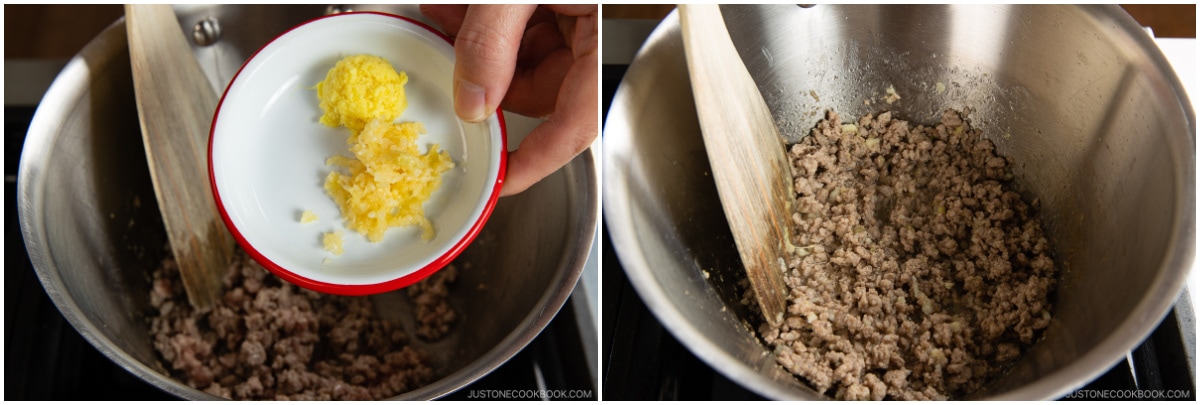
- Add 1 Tbsp doubanjiang (spicy chili bean paste) and 2 tsp soy sauce and stir to mix.

- Lower the stove‘s heat to medium low and let the pork mixture simmer until the cooking liquid is almost evaporated, for about 2–3 minutes. Then, turn off the heat. Transfer half of the pork mixture to a bowl and leave the other half in the saucepan.
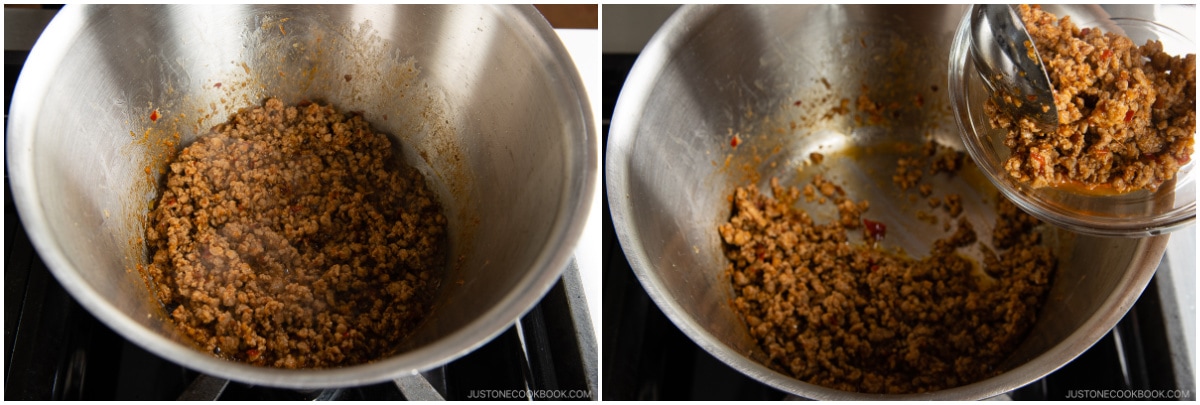
- Cover the bowl with plastic to avoid further evaporation and to keep it warm.
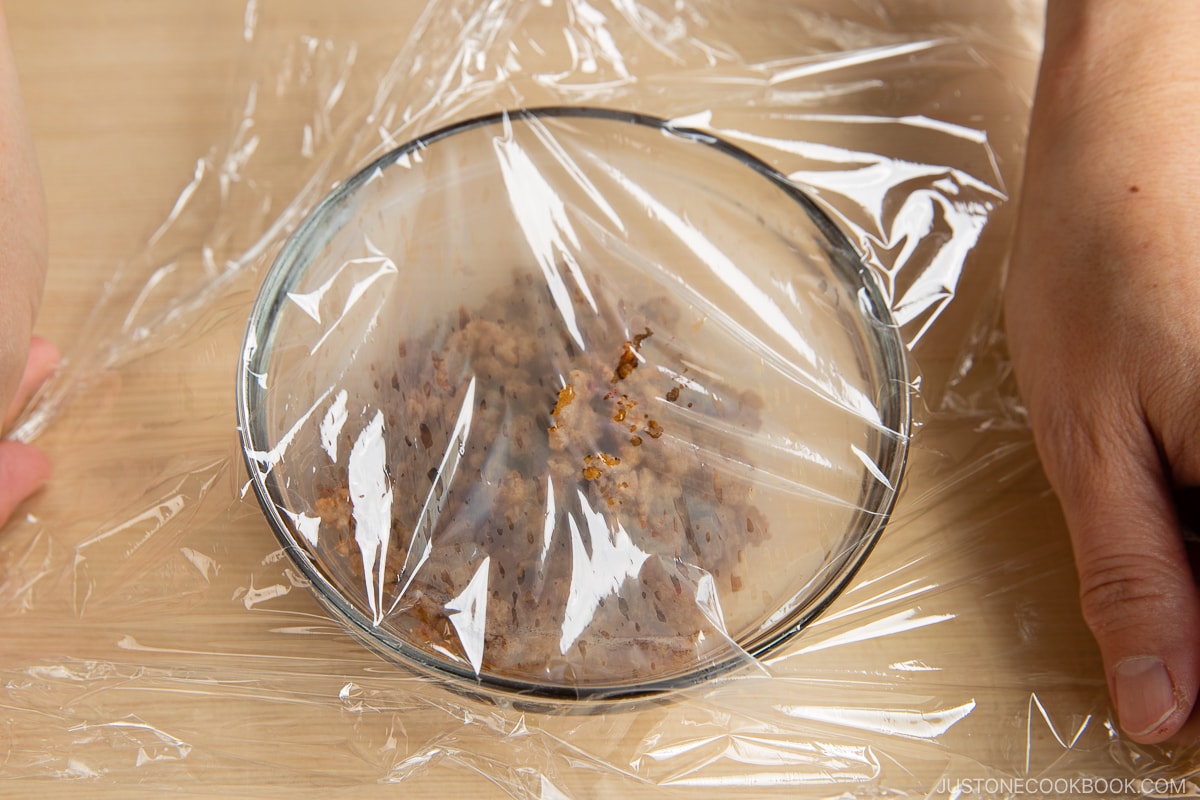
To Prepare the Soup Broth
- With the stove‘s heat off, add the soup seasonings to the pork mixture in the saucepan and mix well.

- Turn on the stove‘s heat again to medium. With a spatula, stir the pork mixture constantly while you gradually add 1½ cups chicken stock/broth, combining them well. Tip: If you add the stock all at once, it‘ll be difficult to combine well.

- Then, gradually add 1½ cups unsweetened soy milk while stirring.

- Taste the soup now and adjust the seasoning with Diamond Crystal kosher salt. Don‘t be shy about adding salt because the broth will taste less salty after you add the noodles. Also, if you feel it‘s too creamy or too thick to your taste, you can adjust the soup broth by adding a few tablespoons of chicken stock or water. Once the soup broth tastes good, turn off the heat, cover the saucepan with the lid, and set aside.

To Blanch the Bok Choy
- Prepare a medium bowl of cold water and set aside. In the big pot of boiling water, add the bok choy, stem end first, and cook it for 2 minutes. When the bottom end is tender, turn off the heat.

- Without draining the water, remove the blanched boy choy from the pot and transfer it to the bowl of cold water to stop the cooking. Keep the hot water in the big pot to cook the noodles in the next step. Once the bok choy is cool enough to handle, squeeze the water out and set aside.

To Reheat the Broth and Cook the Noodles
- Now, it‘s time to reheat the soup broth until it‘s piping hot, but don‘t let it overboil because it may curdle. Before cooking the fresh noodles, loosen them up with your hands.

- Turn the stove‘s heat back on and bring the water in the big pot to a boil again. Once boiling, add 2 servings fresh ramen noodles and cook according to the package instructions. While cooking, stir and separate the noodles with chopsticks. Here, I cook the noodles inside a big noodle strainer (I got it in Japan) that I‘ve set inside the pot.

- When the noodles are done cooking, drain them well in a strainer, shaking it a few times to drain the water thoroughly (otherwise it will dilute the soup broth). Transfer the noodles to the individual ramen bowls.

To Serve
- Divide and pour the soup broth with seasonings over the noodles.

- Place the reserved pork mixture on top of the noodles and place the bok choy to one side to garnish.

To Store
- You can keep the soup broth in the refrigerator for 3 days. Cook the noodles right before serving.
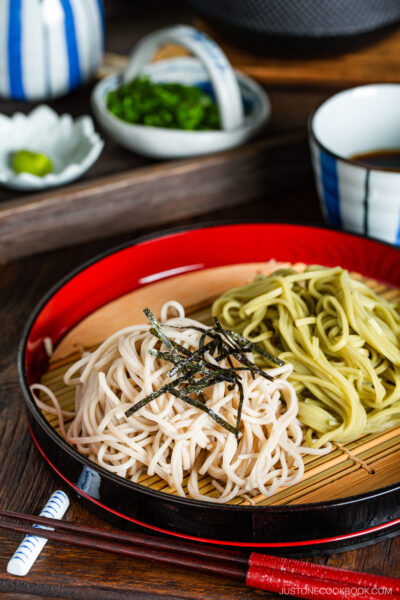
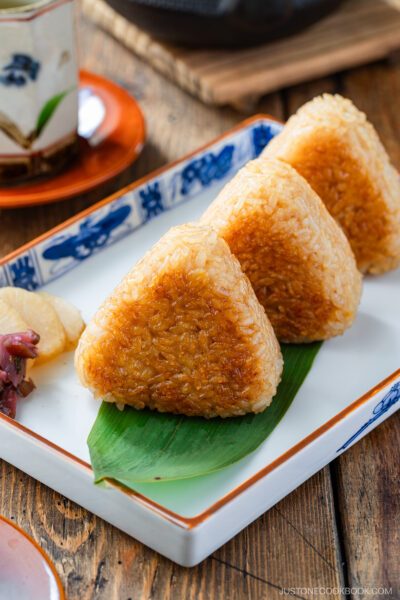






I Made this for my wife who does not have a taste for spicy (fats and spice make it nice). We both enjoyed it and will be adding it to our favorite recipes book.
Hello Brett! We are glad to hear you and your wife enjoyed this dish!🤗
Thank you for trying Nami’s recipe and for your kind feedback. Happy Cooking!
I wanted to say how much I love this recipe. I had tantanmen at a little place near Nippori Station in Tokyo, where they had a guy making hand-pulled noodles in the window. I came back home to California and tried tantanmen at a couple of local restaurants and it just wasn’t the same. It was overly sweet and not the same flavors. (And this is in an area with a large Japanese-American population!) I found your recipe and it is pretty damn close to the tantanmen I had at that little Tokyo place. I buy refrigerated udon noodles from my local Asian grocery store and use those instead of true ramen noodles.
To anyone considering making this recipe, DO IT! It looks a lot more complicated than it really is and once you get the ingredients together, it comes together quickly.
On this latest round, I made it with unsweetened coconut milk because it’s what I had on hand and it was just as good.
Hi, Susan! Aww. We’re so glad you enjoyed Nami’s recipe as much as we do!
Thank you for trying her recipe and sharing your experiences with us.🥰 Happy cooking!
Had a craving for tan tan ramen, but my favorite ramen place was closed. Decided to make it myself using this recipe and it was so delicious! Aside from the bok choy, I added menma (bamboo shoots), sliced black fungus, and a soft boiled egg as toppings. Highly recommend!
Hi Christina! Aww. We are so happy to hear you enjoyed Nami’s recipe.
Thank you for trying her recipe and sharing your experience with us.
Happy Cooking!
This was our first time trying tantanmen and it was delicious! We loved it!
Hi Joan, We are so happy to hear you enjoyed Tantanmen!
Thank you for trying Nami’s recipe and for your kind feedback! 🥰
I just want to say thank you for this recipe. I Discovered it over a year ago and eat it every other week! I I did one extra step, which was boil bonito flakes into the chicken stock to make it a bit more fishy.
Hello, David! Wow! Thank you very much for the kind comments and for sharing the tips with us.
Bonito flakes sound delicious! We’ll give it a try next time. Happy Cooking!
Super delicious! I highly recommend! My family loved it
Hi Ellen! Thank you so much! We are glad to hear you and your family enjoyed Nami’s recipe. Happy Cooking!
Managed to repeat the phenomenon!
Hi Shawn! Aww!😍 Your Tantanmen looks so delicious!
Thank you so much for trying Nami’s recipe and sharing your result with us.
We are thrilled with the outcome!! Happy Cooking!
Glad to have tried this recipe! This dish hits all the decadent notes that you want from tonkotsu ramen without having to spend days in the kitchen.
I used frozen ramen, as well as napa cabbage instead of bok choy, and it turned out great. I also added some green onions because I’m a fiend for negi and I like how they cut the creaminess.
So happy to have been able to use my home-made la-yu chile oil from JOC’s recipe! I made it extra spicy, which was great for this ramen 🙂
Highly recommend! I would have never thought to put soy milk in a broth, but give it a shot.
Hi John! Aww. Nami and all of us at JOC are so happy to hear you enjoyed Tantanmen and homemade La-yu.
Thank you so much for trying Nami’s recipes and sharing your cooking experience with us!
I really liked this a lot- the addition of the soy milk makes this unique among ramen recipes I’ve tried. Made 3 small changes-
1) the doubanjiang I use is oil free- see wikipedia for a typical picture of it. It needs to be minced
finer than it comes in the package for this use and then added a bit earlier to the pork with
just a bit more oil. (Pixian Time Honored brand)
2) my bok choi was quite a bit larger than what is in your picture (where I live what is available varies from baby bok choi to large). Separated the stems and leaves and cut into bite sized pieces.
3) had dried ramen (Hime brand) on hand. Fresh is 12 miles and a bridge toll away. 🙁
From experience I know the ramen takes 4 minutes. Added the stems after 2 minutes and the
leaves after 3. The presentation isn’t quite as elegant (I just dumped the noodles and bok choi
into a strainer). No icing of the bok choi required. 🙁
I make a lot of Sichuan food and would usually add Sichuan peppercorns but instead added some
schichimi togarashi (Home brand) to make it more Japanese and add a wider flavor profile. Yum!
Hi Greg! Thank you so much for trying Nami’s recipe and sharing your cooking experience and tips with us! 🥰
We are so happy to hear you enjoyed Tantanmen!
Slight error in my post. House Shichimi Togarashi (300g) is the brand I’m currently using. Easy error to make- I buy, use and swap parts of this bulk package. My table side shakers are all S&B- I just keep refilling this one (Shichimi Togarashi) faster than the ichimi or nanami varieties.
Hello, Greg! I see! What a brilliant idea to buy a large bag of Shichimi Togarashi! Thank you for the update and advice!
This was a keeper! Amazing. Just subbed out with spinach instead of bok choy. Thanks for sharing your recipe!
Hi Kpp! We are so happy to hear you enjoyed the Tan Tan Ramen!
Thank you so much for trying Nami’s recipe and for your kind feedback. Happy Cooking!
Hello!
I tried this recipe tonight. I made a couple changes: tofu instead of pork, gochujang instead of doubanjiang (because I couldn’t find it), and used less chili oil so it wasn’t as spicy. It was super delicious, would make again. Thanks for sharing the recipe!
Hi Sydney! We are so happy to hear you enjoyed the dish!
Thank you so much for your kind feedback and sharing your cooking experience with us.
Happy Cooking!
I made this yesterday and I loved it. It was spicy, full of flavour and it made me so happy eating it. Having it again tonight so a total success!
Hi Esther! Thank you so much for trying Nami’s recipe and for your kind feedback!
We are so happy to hear you enjoyed the TanTan Ramen! Happy Cooking!
In Japan, I think over 99% of local people will view the Tan-Tan men as a typical Chinese food, not a Japanese food at all.
Hi there! I appreciate your comment.
As I explained clearly in the post, Tantanmen is a Japanese adaption of the Sichuan dish. Similar to gyoza, mapo tofu, and other ramen dishes, it is considered a chuka ryori (中華料理, Japanese-Chinese) dish, which is a part of Japanese food culture.
If you wish to learn more, here is an article about Japanese Chinese food:
https://www.justonecookbook.com/chuka-ryori-japanese-adaptation-of-chinese-cuisine/
Tantan men and Dandan mien are subtly different, and both delicious. My Japanese friends know the diff.